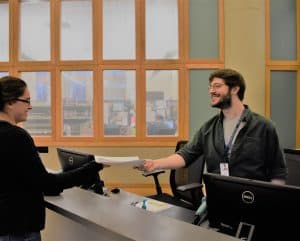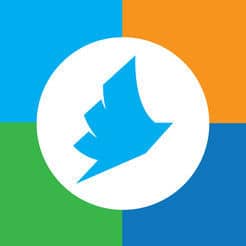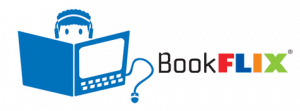calsfoundation@cals.org
Library On Demand: Mobile Printing Joins Digital Services at CALS
CALS is delighted to announce the addition of mobile printing to our digital services. Mobile printing increases access and convenience for patrons who need printing capability for work, school projects, or community groups.
Mobile printing makes printed materials a quick takeaway service
 From any digital device, a patron can now send a document to be printed at a convenient CALS library branch by email, by mobile app, or by uploading with the easy-to-use forms on the CALS website. A full explanation and email addresses can be found here: Printing your documents at CALS.
From any digital device, a patron can now send a document to be printed at a convenient CALS library branch by email, by mobile app, or by uploading with the easy-to-use forms on the CALS website. A full explanation and email addresses can be found here: Printing your documents at CALS.
No more fumbling with flash drives or sitting for an hour to generate a document on a branch library’s computer. Instead, a patron can simply email a printing job to the closest branch, show up, pay nominal printing costs, and walk away with the printed copy in minutes. Documents will be held in the print queue for up to 24 hours.
For 10 cents a page (black and white) or 50 cents a page (color), patrons now have convenient access to printing power for resumes, flyers, research articles, or school papers. Using mobile printing is like ordering a takeaway pizza. Ordering in advance from anywhere in the city streamlines the printing experience for those who need to get their documents quickly.
Convenient addition to wide array of CALS digital services and resources
Nathan James, CALS Deputy Executive Director for Technology and Collection Innovation, thinks that mobile printing will be a valuable addition to the array of self-service digital resources from the library system. “Libraries provide a lot of important community services in the twenty-first century,” James said. “We are always seeking new ways to offer resources that our patrons can use from remote locations, at their convenience, so the whole community can benefit from the library.”
James explained that the mobile printing initiative is well worth the startup effort required. “Printed documents are a crucial requirement for job applications, for school, and for community activities, and if CALS can offer more convenient access to printers for local neighborhoods, we’re going to do it.”
Increasing use of digital, mobile library services
James sees a link between the digital model of mobile printing and the popularity of other digital resources that patrons can use at any time, from anywhere. “Use of our digital collections is rising rapidly,” James said. “As a larger percentage of patrons grow comfortable with the electronic world, we know we will see that trend continue.” Ebook borrowing increased by 10 percent from 2016 to 2017, and digital audiobook borrowing rose by 24 percent. CALS now provides digital access to 56,202 ebook titles, and 16,152 titles in audiobook format.
As CALS keeps up with technological advances, library services are no longer bound by physical location or standard work hours. At any time of day, we can order library books that fly invisibly through the air and land in front of us on a digital page. From any vacation spot, we can choose from a huge selection of free audiobooks and download several on our cell phones. Music and full-length feature films stream or download to our devices. And all these digital, on-demand resources are available for free from the library system.
Digital resource users cite instant, free access as benefit
Patrons love the convenience of the digital library. Helena Shulze described how she uses audiobooks while walking or gardening. “It is so nice to listen to a book while I trudge along at my work,” she said. “There are so many choices given by the mobile apps that I never lack for a good read.”
Marla Lemmerman also appreciates the CALS digital holdings. “I can check out a book in mere minutes without having to leave the house. Plus, they are good for the environment because I’m not having to use gas to drive to the store or library, which reduces my carbon footprint. And there’s no paper.”
Sometimes scheduling makes digital resources the best option for patrons like Pam Cameron. “Because of my work schedule, it’s not convenient to visit the library, but I read all the time on the Libby app,” she said. “The wait time for popular books isn’t bad either.”
I don’t think people realize how easy it is to download audiobooks and ebooks.
Cassie, CALS Patron
Jane Jones-Shulz has found the library’s digital offerings to be helpful for her budget. “I have listened to audiobooks for years and was only limited by their costs,” she said. “To have them available from my library with just a click is amazing!”
The most common reason that patrons cite for not taking advantage of digital streaming or downloads is lack of familiarity with the apps. But when patrons try it out, they often find that digital borrowing is not difficult. “I don’t think people realize how easy it is to borrow and download audiobooks and ebooks,” said patron Cassie Baldwin. “Trust me, I’m no computer genius. Anyone can do it.”
Help available for patrons to learn easy steps to use digital services
 For those who do feel in need of assistance to learn how to use the digital resources, the library offers regular classes to walk patrons through the process. Harry Pratt attended one of those classes in August at the Terry Library branch on the west side. “I thought the informational session was very clear,” he said.
For those who do feel in need of assistance to learn how to use the digital resources, the library offers regular classes to walk patrons through the process. Harry Pratt attended one of those classes in August at the Terry Library branch on the west side. “I thought the informational session was very clear,” he said.
Another “anywhere, anytime” digital service offered by CALS is access to online digital learning. Access to education from home can be life changing, particularly when a patron acquires new skills or certifications. Sarah Ricard discovered the advantages of this service. “Having Lynda.com / LinkedIn Learning as a free resource to card holders has opened up learning opportunities for me,” she said. “I was able to use it from my personal laptop.”
Libraries of the 21st century: citizens speak out on why libraries are”much more than books”
The rising use of digital resources has caused some people to wonder about the necessity of physical libraries. In July of this year, an economist suggested in Forbes magazine that Amazon stores should replace public libraries. The suggestion of eliminating public libraries in favor of a pay-for-service store proved so wildly unpopular that Forbes took down the article after two days.
Like those who responded publicly to the Forbes article, CALS patrons are also quick to explain that digital space cannot replace the library’s many public services.
I do crafting and cooking classes at the library. I attend cons at the library. It’s not just about the books.
Christa, CALS Patron
Patron Christa Abernathy-Meredith feels that the library provides a community environment where people can learn and grow. “My Girl Scout troop meets in the library,” she said. “I do crafting and cooking classes at the library. I attend cons at libraries. It’s not just about the books.”
“What’s not to love about public libraries?” asked patron Michelle Mills. “I love the ease of getting any book I’d like, the spaces that can be used by the community, the access to computers & internet for anyone who needs it, the programs for kids & adults…so much to appreciate!
Vickie Stewart also referred to the wide variety of programs at public libraries like CALS. “I like the libraries because now they offer so much more than just books,” she said. “You can brush up your skills on Microsoft and learn how to use the computers. Such nice and knowledgeable people work there and they are nice to everyone.” She gives the public library credit for helping her in a concrete way. “I made an A in my history class in grad school at UA Little Rock, thanks to CALS.”
After the economist’s suggestion to eliminate public libraries, scores of editorials appeared across the country in response. Journalists and citizens from all walks of life spoke out to defend the institution of the American free public library, citing the opportunities that libraries make available to all citizens. From the massive public response, it’s heartening to realize that even as technology changes our society at a dizzying pace, public library buildings aren’t going anywhere.
Instead, thanks to digital offerings like books, music, movies, online classes, and now mobile printing, public libraries can go everywhere a patron can go.







